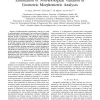Free Online Productivity Tools
i2Speak
i2Symbol
i2OCR
iTex2Img
iWeb2Print
iWeb2Shot
i2Type
iPdf2Split
iPdf2Merge
i2Bopomofo
i2Arabic
i2Style
i2Image
i2PDF
iLatex2Rtf
Sci2ools
CBMS
2015
IEEE
2015
IEEE
Automated Detection of 3D Landmarks for the Elimination of Non-Biological Variation in Geometric Morphometric Analyses
—Landmark-based morphometric analyses are used by anthropologists, developmental and evolutionary biologists to understand shape and size differences (eg. in the cranioskeleton) between groups of specimens. The standard, labor intensive approach is for researchers to manually place landmarks on 3D image datasets. As landmark recognition is subject to inaccuracies of human perception, digitization of landmark coordinates is typically repeated (often by more than one person) and the mean coordinates are used. In an attempt to improve efficiency and reproducibility between researchers, we have developed an algorithm to locate landmarks on CT mouse hemi-mandible data. The method is evaluated on 3D meshes of 28-day old mice, and results compared to landmarks manually identified by experts. Quantitative shape comparison between two inbred mouse strains demonstrate that data obtained using our algorithm also has enhanced statistical power when compared to data obtained by manual landmarki...
| Added | 17 Apr 2016 |
| Updated | 17 Apr 2016 |
| Type | Journal |
| Year | 2015 |
| Where | CBMS |
| Authors | Deepali Aneja, Siddharth R. Vora, Esra D. Camci, Linda G. Shapiro, Timothy C. Cox |
Comments (0)

